
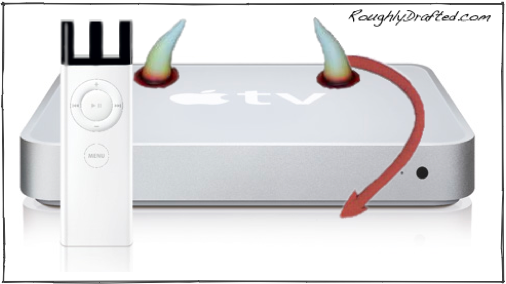
Ten Myths of the Apple TV: Xbox and Hardware
Almost three months ago, Ten Myths of Apple iPhone overturned misinformation on that device before it could get started, although self-styled analysts kept trying to perpetuate them for months afterward.
The iPhone isn’t out for another three months but the Apple TV is here now; as a follow up to Inside Apple TV, here’s Ten Myths of the Apple TV, relating to 5.1 audio, comparisons with the Xbox, cables, pricing, widescreen, hardware, software, and even its devilish remote.
Myth 2: Apple TV is just like the Xbox, but can't play games!
Comparisons to the Xbox 360 come from the fact that the 360 can also be used with a Window Media Center PC to view content on a TV. That's the sole purpose of the Apple TV, which does not play games.
While Apple might offer games or other application upgrades in the future, the Apple TV will never compare to the latest generation of dedicated game consoles, simply because it lacks the processing power. It is likely that Apple will start offering interactive applications and games on the level of the iPod's Games, and if it doesn't, hackers will do it for them. It’s just a Mac, after all.
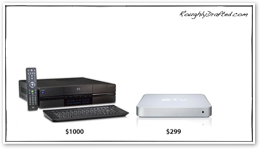 Of course, nobody thinks the Apple TV is a stand in for a dedicated game console. The real question is how well the Xbox 360 works as a Media Center Extender.
Of course, nobody thinks the Apple TV is a stand in for a dedicated game console. The real question is how well the Xbox 360 works as a Media Center Extender. The answer is: it's an okay stretch for users who already own a 360 and want to use Media Center. That excludes Mac users, because Media Center is tied to Windows. It also excludes the majority of Americans, as less than 11 million 360s have been shipped to stores.
For Windows enthusiasts, the 360 works fine, if you don't mind having a full power game unit running all the time. The 360 is loud and large, and uses a big remote control. If big loud things impress you, then you'll be rushing out to relieve retailers of one of the 360s sitting in piles on their show floor.
There's a reason why the 360 isn't selling very well: it's really only good at playing games, and now faces credible competition. Consumers haven't been tricked into avoiding Windows Media for iTunes; the majority have just determined that Apple’s system works better.
Myth 3: Apple TV the same price as the Xbox!
Paul Thurrott, in his rush to bash the Apple TV, insisted that "for the same price, you could get an Xbox 360 and use that device to stream media" from Media Center. The difference, he says, is that the 360 can download HD content and play DVDs. "Yes, the thing sounds like a wind tunnel, especially when its playing games, but it's far more versatile and powerful device than the Apple TV. And it costs exactly the same price."
He's speaking past his knowledge of course, which is sad since he makes his living shilling for Microsoft's products. The truth is that you can't download movies to an Xbox without a hard drive.
It’s only the Core Xbox 360 system that is the Apple TV's $300 price, and the Core unit lacks a hard drive.
To get a hard drive, you'll need to either buy the $100 hard drive option, or spring for the $400 Premium Xbox system.
Want wireless networking? That's another $100 option, but don't expect the fast Wireless N included in the Apple TV; that's not yet even an option for the Xbox 360.



Yes, that's right, while Thurrott scoffed at the Apple TV's 40 GB drive for being too small, he makes no mention of the fact that the $100 hard drive option required to download movies on the 360 is only a 20 GB drive--half the size.
A new Xbox 360 Elite model is planned to offer an HDMI connector and an external 120 GB hard drive--a $200 option--but still no wireless networking and no built in hard drive. It is slated to cost $479.
"Exactly the same price?" Only if you get free stuff from Microsoft in exchange for misrepresenting the company's products and posting an utter trash review of any and all competitive products.
Paul: stick to talking about Windows, because when you're not being fed talking points, you don't know what you're talking about.
Myth 4: Everyone Who Wants This Already Has an Xbox 360
It seems worthy to point out that Microsoft's shipments of Xbox 360 units aren't related to users buying them, but rather to simply fulfilling goals. That goal fulfillment has stuffed the channel with unsold units to create the impression that Microsoft's sales are far more impressive than they actually are. Consider:
-
•In October 2005, Microsoft announced it would sell 4.5 to 5.5 million 360 units between its launch and the middle of 2006, to take advantage of its year head start in delivering the next generation of game consoles.
Sure enough, by the middle of 2006, Microsoft had shipped 5-6 million units. In the third quarter however, the company's shipments dropped in half. Despite that major drop in supply, there was no shortage of units.



Either supply had far outpaced demand before the middle of 2006 and stores were simply full of unsold inventory, or there was a sharp decrease in demand.
In either case, Microsoft was now faced with too many Xboxes and not enough buyers. But wait, it had only made its mid-2006 goal!
Now it had to ship another 5 million units by the end of the year. How would that happen if there was slack demand and stores were already full?
That’s easy: in the fourth quarter, Microsoft again simply dumped 4 million more units on the market even though there wasn't significant demand. Unsurprisingly, they didn't magically sell themselves. They’re still in stores, as anyone who visits a retail store can observe. Lots of them!
Live Subscribers
With every Xbox comes a free starter subscription to Microsoft's Xbox Live online service. Despite dumping out enough machines to fill Gate's promise of 10 million units shipped, the company only advertises that 5 million people subscribed to Xbox Live by the end of 2006.
Did half of the Xbox users forget to subscribe for free, or did Microsoft actually count everyone who had bought an Xbox and signed up? Obviously, there were really only about half as many units sold in 2006 as there were shipped to meet Gates' blustering quota.
Unsurprisingly, after dumping those four million units on stores, the company retreated back on new shipments and announced a new goal: to only ship another two million units over the next six months.
Binge and Purge
How can it sell 6 million in 8 months, then 4 million in 3 months, then only 2 million in six months? Microsoft feeds the channel like it's a voracious bear, which then hibernates for months living off its fat reserves.
Sony similarly counts every unit is ships to retailers, but it isn't shipping more than users can buy; it's still hard to find the PS3 in stores. Nintendo actually sold over three million Wii units in November/December, and despite very highly constrained supplies, recently reported shipping another three million in the Q1 2007.
Retail data shows that the Wii outsold the Xbox in January. But that compares two sets of data that doesn't match up: actual reported shipments from manufacturers vs. NPD's retail numbers observed in stores.
Clearly, Microsoft hasn't actually sold 10 million units; it’s still waiting for millions of units to clear out of stores. As they do, NPD counts them again in its retail sales announcements!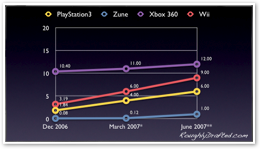

So much good news for Microsoft: it meets its goals and maintains sales in stores. The only problem is that it’s all fake; that double counting will soon collapse as rival console makers begin selling in quantity.
Microsoft is working hard to perpetuate an illusion that the Xbox 360 is selling huge numbers and is way ahead of everything else, but the reality is that 360 sales are not going well, despite Microsoft's use of DirectX and the Windows monopoly to push games as exclusive to the Xbox 360 and Windows Vista.
Given that the Wii game console has already actually sold as many units in less than six months as Microsoft actually sold in more than a year, trying to suggest that the 360 will edge out the Apple TV as a TV media player is even more absurd. The Xbox is not even usable for most people as a media player.
Myth 5: Apple TV Only Works with Widescreen HDTVs.
David Pogue's review of Apple TV stated, "The heartbreaker for millions, however, is that Apple TV requires a widescreen TV - preferably an HDTV. It doesn't work with the squarish, traditional TVs that many people still have."
Paul Kafasis of Rogue Amoeba appeared to be the first to point out that--despite Apple's listing of widescreen TV among the requirements--the unit does happily work with most any TV that offers component video inputs.
That includes millions of non-widescreen, standard definition, non enhanced sets built in the last half decade. Like my old RCA TV.
Myth 6: For $300, Apple TV Should Include the Cables!
Rogue Amoeba also pointed out that the device doesn't ship with cables; you have to buy them separately.
"I don't have any HDMI or component cables," Kafasis said, adding in a footnote, "As you might expect, I do have plenty of RCA audio cables lying around."
Rogue Amoeba is the developer of Airfoil and Audio Hijack. The first allows you to stream audio from any application to an AirPort Express, while the second allows you to record audio from any application. Get it? He’s an audio pro and only has audio cables. Most people, in fact, are likely to lack extra HD video cables.
I found myself without a component cable as well, but I just used a 3 way RCA 'stereo plus composite' cable, which worked fine. It's not color coded the same, so you have to line up the yellow, red, and white on the cable with red, green, blue component ports in the same way on both ends.
No doubt the gold foil on connectors of audiophile purists are peeling off at the dreadful thought of using cheap cables, but it does work. If you have an expensive TV, you will probably want to spring for high quality cables.
Why doesn't Apple just throw in the cable? Well, since the Apple TV has two video output options and two audio output options, and there are at least three video input options on displays--HDMI, DVI, and component--that would require Apple to include five cables and/or adapters just to cover the bases for most users.
Add in European customers with SCART connectors, and that goes up to six. How long should those six cables be? A minimal 2 feet, because the box is intended to sit next to the TV, or fairly long because users will be routing it to their receiver?
It quickly becomes obvious why Apple doesn't include cables, because there are too many options to fit the needs of most users adequately. It would be a huge waste.
Imagine what Greenpeace would have to say about all that excessive and “toxic” PVC wrapping on the cables, and think of all the children around the world that would be strangled by Apple branded cables, simply because Apple doesn't pay Greenpeace to participate in its 'green' protection racket. Oh the humanity!
Myth 7: Paul Thurrott Can Review the Apple TV
In writing this article, it looks like John Malloy beat me to it on pointing out the absurdity of Thurrott's "exactly the same price" comment about downloading movies and rentals from Xbox Live.
Thurrott then jumped all over Malloy of course, insisting that the Core Xbox can act as a Media Center Extender without a hard drive. Except that's not what he said, so it's not a defense. You can't say misleading foo, then say 'but I meant bar," without apologizing for misstating foo.
The most bizarre comment is Thurrott's summary, which recounts "John [Mallory] says that you can't expect Paul Thurrott of SuperSite for Windows fame to write fair reviews of Apple products, despite much evidence to the contrary."
Thurrott linked 'much evidence to the contrary' to an overview of his earlier ratings of several iPods and iTunes, which he gave high marks overall. If you actually read his reviews however, it's obvious that his four star ratings don't capture his very clear message. In his "evidence” of a fair review of iTunes, for example, Thurrott writes:
-
•“visualization options in iTunes 7 are straight out of the Windows Media Player 11 playbook”
-
•“[Apple] completely ripped off WMP11 for iTunes.”
-
•“Apple generally just rips off ideas without paying for them.”
-
•“I've argued that the quality of the music that Apple sells from its online media service, iTunes Store, is lousy. And it is. Foisting 128 Kbps files on unsuspecting consumers should be punishable by public flogging. Despite this, no one seems to care. The last time I checked, Apple has sold about a bazillion songs online, far more than the 17 or 18 Napster and MSN Music have sold combined.”
Yes, he obviously has nothing against Apple, apart from the need to suggest that everything Apple does is in the shadow of Microsoft, basically theft, commonly poor quality, and only succeeds because of mysterious factors that can only be explained by the religious zealotry of a minority that’s too small to even matter.
Recall that Thurrott earlier wrote that iTunes was a dangerous monopoly, and “Apple should be stopped before the abuses get too great and harm too many consumers.”
Giving iTunes a high rating doesn’t really make up for years of non-stop, insane criticism.
The saddest part is that he always has to admit that Apple actually delivers what Microsoft only plans to do. Perhaps that’s the real reason Apple’s products are interesting and popular.
It’s fine for Thurrott to love Microsoft and hate Apple, but why be a hypocrite about it and profess to be unbiased and fair when that’s obviously not the case?
Back to trashing the Apple TV, Thurrott also brings up myth number 6, and invents myth number 8 as a way to distract from his being owned by ZDNet, of all sources:
Myth 8: The Apple TV is So Hot It Will Interrupt Your Movie Satisfaction
After Malloy points out that the Xbox 360 is “as loud as can be imagined” and therefore a distraction and poor alternative for trying to watch home theater movies with nice sound, Thurrott concedes that the 360 is “absolutely louder than the Apple TV,” then throws his readers a distracting talking point:
“The Xbox 360 is louder than the Apple TV. I'd add that the Apple TV runs quite hot (I also mentioned this in my review), and is, in fact, too hot to touch after being in use for a while.”
Yes I hate it when I'm watching a movie in my living room, and then walk over and stick my face on an appliance only to discover it is uncomfortably warm. It really ruins the whole movie experience, and is similar to having a leaf blower screaming along right there next to me during the show.
Myth 9: Apple TV OS is Available for Download!
Another font of misinformation, Digg, was used to spread the idea that one could use a disk image of the Apple TV drive in some way. Except that you can't. After downloading the huge disk image file that some rube put up for download, many were disappointed to report that the image wouldn't mount.
For starters, why would anyone want to covert an existing Mac into a more limited Apple TV? It would only do less. Any Mac that can boot an Intel Mac OS X image is worth more than $300. Ebay it, buy an Apple TV and enjoy the extra cash left over.
What about using the Apple TV image to create a cheap PC alternative? Ha: the myth of the cheap PC! Try assembling a PC for $300 with HD video output, wireless networking, IR, and digital audio. The Apple TV is really good at being cheap. Apple is an engineering company, and can therefore target products to meet goals.
Apple's desktops and laptops have always aimed at delivering a premium computer, but when Apple aims at delivering an cheap PC for a very targeted purpose, it can nail it, because the company has the resources to develop a highly customized box, working directly with Intel and other suppliers to dial it in to do exactly what it's intended to do at a specific price point.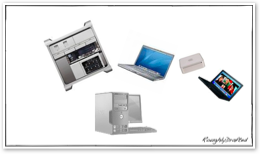

Cobbling together a generic PC gives you larger, hotter and/or noisier box, albeit one that can probably light up in a blue glow. The other barrier of course, is that Macs use EFI.
A year after Apple introduced its EFI Intel Macs, there still aren't EFI PCs or logic boards to use, so a disk image of the Apple TV is beyond useless for this too.
Apple also doesn't want people stealing its operating system, so it has introduced some measures to slow this from happening. But the biggest barrier to ripping off the Apple TV is that it's simply a lot of impractical work and expense to duplicate.
Myth 10: Apple TV’s Remote freaks out all my Macs!
Anand Lal Shimpi writing on Anandtech--the site that insisted Apple needed to replace Darwin with the Linux kernel for adequate performance--reported being freaked out because the Apple Remote he intended to use to control the Apple TV also wakes up other Front Row computers in the room.
To banish this witchcraft, you can either dunk your Macs in the lake until they confess or die--or alternatively--pair the remote to the Apple TV, so that other computers with IR ports will ignore it. You can also cover up the IR receiver on all your other Macs, as Shimpi did in the article.
Warning: dunking computers in a lake will likely void your warranty, even if it does manage to dispel the arcane invisible light magic of Apple’s Front Row Macs.
[An Apple Remote can be paired with the Apple TV using its on screen menus or with any Front Row Macs.
Reader David Lawless suggested adding this note on how to do it:
“You can pair a remote to a given computer by following these instructions:
1. Hold the remote close to the computer (3 to 4 inches away) and point the remote at the front of the computer.
2. Press and hold both the Menu and Next buttons on the remote until the paired-remote graphic appears on your screen (about 5 seconds).” ]
Like reading RoughlyDrafted? Share articles with your friends, link from your blog, and subscribe to my podcast!
Did I miss any details?
Next Articles:
This Series


 |
|
 |
|
 Del.icio.us |
Del.icio.us |
 Technorati |
About RDM |
Forum : Feed |
Technorati |
About RDM |
Forum : Feed |

Wednesday, March 28, 2007







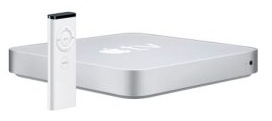
 Send Link
Send Link Reddit
Reddit Slashdot
Slashdot NewsTrust
NewsTrust





